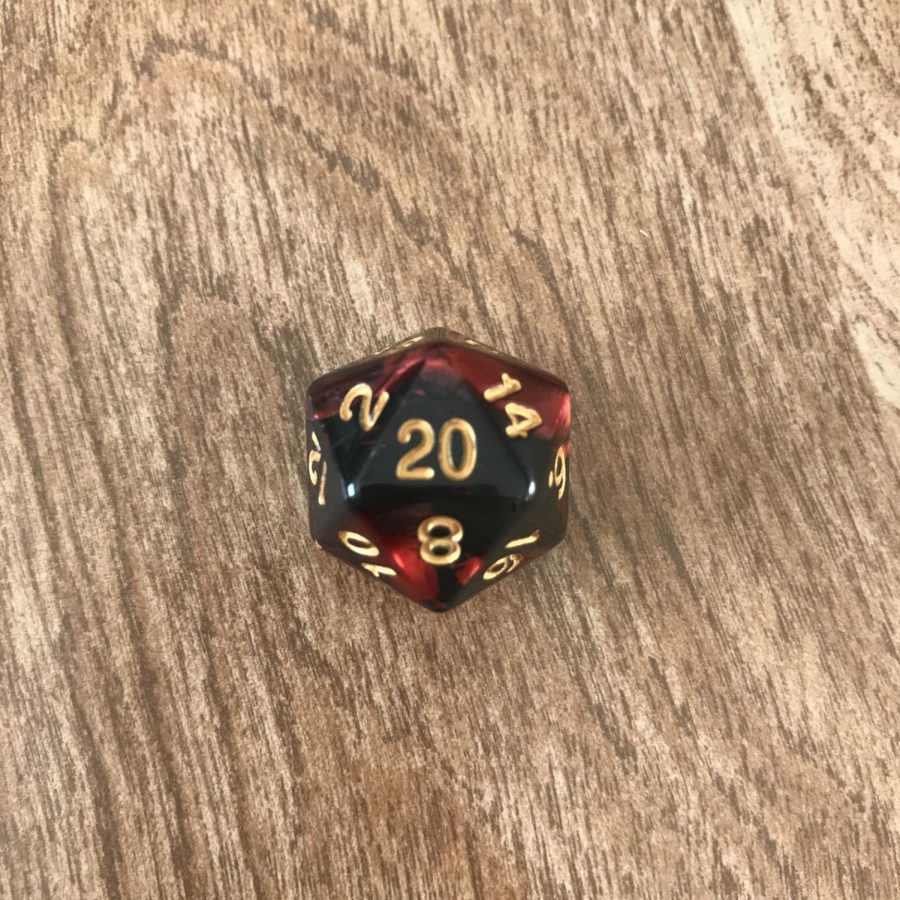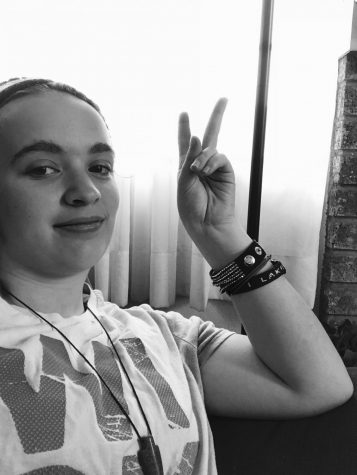Roll the Dice
November 3, 2020
By Kai Barr
If you’ve ever watched Stranger Things, then you’ve probably heard of the tabletop RPG game Dungeons & Dragons. Heck, even if you just went to Righetti’s rendition of Qui Nguyen’s She Kills Monsters play, then you’ve heard of it. (Speaking of that play, it was great, but I guessed I’m biased since I was in it. But that’s not what this article’s about.)
Now, some people think that Dungeons & Dragons is something for nerds, or losers, or <insert slightly outdated insult here>. Is it nerdy? Oh, one hundred percent, but hey, if it’s cool enough that Finn Wolfhard, Noah Schnapp, Gatan Matarazzo, and Caleb McLaughlin can play it together then it’s cool enough for me. Yes, I’m aware they’re acting the whole time—acting is basically their job, after all. Now, I’m sure you probably want to know why I’m writing about Dungeons & Dragons, of all things. I could be sharing some spooky stories or maybe some recipe for a pumpkin spiced latte that’s probably out at Starbucks by this point (hey, they’re good. I’m not enough a super Starbucks-going person but they make great drinks). I could be sharing more cat facts or something about Halloween was a holiday where people would dress up in masks to make sure demons didn’t take them, or something three hundred times more interesting to some of you. But I’m not going to do that, I’m talking about Dungeons & Dragons because it is one of, if not the, greatest tabletop RPG of all time.
Now, you might think “oh, you’re biased. You probably play D&D on the weekends with your friends”. Or, you would, if we were allowed to go to friends’ house and play D&D on the weekends without the hassle that is Zoom. Much like how I’ve played Minecraft for the past eight years and never mined a single diamond or gone on Hard mode, defeated the Ender Dragon, killed a silverfish in Survival, etc., etc., I have never actually played a single game of D&D. So, why do I think it’s such a great game? Thanks for asking (and if you don’t want to be here, exits should be conveniently located throughout the webpage). I’m going to give you three reasons why, so let’s jump right into that!
Reason #1: Dice are shiny
Starting off with the goofiest reason I could come up with, D&D gives you access to quite a few dice. D6s, D8s, even the vicious D4s (which you do not want to step on in the middle of the night, those are also called caltrops). There’s also the ever-so-famous D20, also known as an icosahedron for you fancy folk.
Now, there are a lot of different dice out there. You can even make your own at home if you have resin and silicone molds, although they might end up with a lot of bubbles if you don’t have a pressure pot. (For that kind of thing, check out this video by Rybonator! It’s a really nice channel and it has a lot of different dice-making videos.)
So, if you’re someone who likes shiny math rocks, as some members of D&D’s vast fandom (I guess it’s a fandom, maybe a fanbase?) call them, playing D&D gives you a viable reason to have a bunch of different sets. I haven’t even played D&D yet, and I have over 10 sets. You can have ones for different characters, different spells, and even different moments for a character. And don’t forget, you can also have a dice jail for when you’ve rolled three nat 1s in a row and managed to get Glory Nowhere the Tiefling Cleric killed. On the topic of characters, let’s segue into our next point—
Reason #2: Characters
Now, you might be wondering what the heck I mean by “Glory Nowhere the Tiefling Cleric”. You may have understood all or only some of those words separately. In D&D, you get to make a player character, or PC. Now, I only have one book for reference (the Player’s Handbook that I, ahem, “borrowed” from my brother’s room for an undetermined amount of time. For research reasons, of course. I’ll put it back…sometime soon), so please forgive me if I get anything wrong or if I leave anything out. If you won’t, whatever, I guess that’s on you.
Anyways, back to the topic of characters. When making a character, you have so many different options to choose from. Not only are there the basic fantasy races—humans, dwarves, elves, orcs, etc—there are more options. Tieflings are just one of these options. Others include the mighty dragonborn, the short halflings and gnomes, the graceful half-elves. On top of that, you don’t just have to stick to these races! Fans have homebrewed (basically created) their own races for decades, and species such as the Tabaxi, the Aasimar, Tritons, and even more have been included in newer editions of the game! And the character customization doesn’t stop there!
Is your character a stickler for rules? Are they an absolute chaos gremlin who does what they want, when they want, no matter the consequences? Are they a wild card who no one can figure out? Well, that’s your alignment! Lawful good, chaotic evil, true neutral, and all the possible mixes in between. Well, not all of them. Most characters, if not all, fall into the basic measure of lawful good, neutral good, chaotic good, lawful neutral, true neutral, chaotic neutral, lawful evil, neutral evil, and chaotic evil. (Yes, if you’ve ever seen those memes, it’s that chart.) Some races have a tendency towards one alignment—for instance, elves tend to be on the chaotic side of things, humans are absolutely everywhere from north to south and east to west on that thing, and dwarves lean towards the lawful good side of it. Of course, this doesn’t mean you have to be these alignments, and that actually can help with your character creation.
So, let’s take a mountain dwarf fighter (that’s a class, I’ll get onto that in a minute) named…Kathra Frostbeard. (Yes, women dwarves can have beards. People in real life can have beards because genetics are funky little things.) So…Kathra sees that her brothers Kildrak and Adrik are obeying the rules to a T, being picture-perfect citizens. And she’s sitting there, thinking, “Oh heck no, that’s not me,” and pulls a Disney-princess “I’m going to go and fight a dragon because I can”. She would count somewhere on the chaotic spectrum of the alignment chart, but being “chaotic evil” doesn’t always mean you’re bad.
Now, since we have Kathra for an example, I’m going to use her for the rest of this. Onto classes! Now, what’s a class? Well, I don’t mean something like Algebra 2, PE, or even something like Creative Writing, Journalism (great class with Mr G.), or Film (also a great class with Mr G., you should take it. I do actually have the ethos for that, I’ve been in the class and it was great). No, I mean class like the following: druid, cleric, fighter, barbarian, ranger, rogue, sorcerer, wizard, warlock.
Now, Kathra is a fighter class. What does that mean? Well, fighter class PCs are members of the most diverse class. Are you a knight on a quest? An elite foot soldier? Maybe you’re a bandit king or his hardened mercenary. Congratulations, you are part of the fighter class! This also includes military officers, bodyguards, knights, all the trained fighters. They are trained for danger.
There are more stats than just that epic background, though. Kathra’s HP (Hit Points/Health) falls to a single d10 for every fighter level (because multi-classing, such as being a ranger with several levels in, say, druid or sorcerer, is a thing). At first level, Kathra’s hit points will actually be 10 plus whatever her constitution modifier will be (also more complicated stuff I will go into with the tomato theory). After that, her HP will be added to with 1d10 with the constitution modifier per level. Additionally, she’ll be good with all kinds of armor, simple weapons, and martial weapons. She gets two skills between Acrobatics, Animal Handling, History, Insight, Perception, Survival, Athletics, and Intimidation. She’ll also start with the choice between chain mail or leather armor, a longbow, and twenty arrows; a martial weapon and a shield or two martial weapons; a light crossbow and 20 bolts or two handaxes; and a dungeoneer’s pack or an explorer’s pack.
Sounds pretty fun, right? Well that’s only the start of it.
Reason #3: The Cheesy One—Making Friends
You can actually make friends while playing D&D, or really any tabletop RPG. Whether it’s going to the library (y’know, when libraries actually open up again) to play a homebrew D&D game with some other college students who invited you or doing a 50-player massive campaign at a convention.
Not only will you be meeting new people, you’ll also gain new skills. D&D is all improv, and you’ll be learning how to solve complicated problems as a team with other people. It also looks pretty good on a resume if you word as something other than D&D. And no, that’s not lying. When you’re meeting for an indeterminate amount of time every week and working with others to solve complex problems together, then that is exactly what you’re doing. D&D is just another name and a fun way to phrase it so you don’t sound like one of the stiffest stick in the muds ever. Or just…someone who really likes fancy words.
But yeah, that’s my three reasons for why you should play D&D! Feel free to order a bunch of dice on Amazon (seriously, look up deals, you can spend $6.99 on one set of Chessex dice or $22.99 for fifteen sets of non-brand dice. There’s nothing wrong with either choice, it just depends on whether or not you feel like paying a certain amount.)

